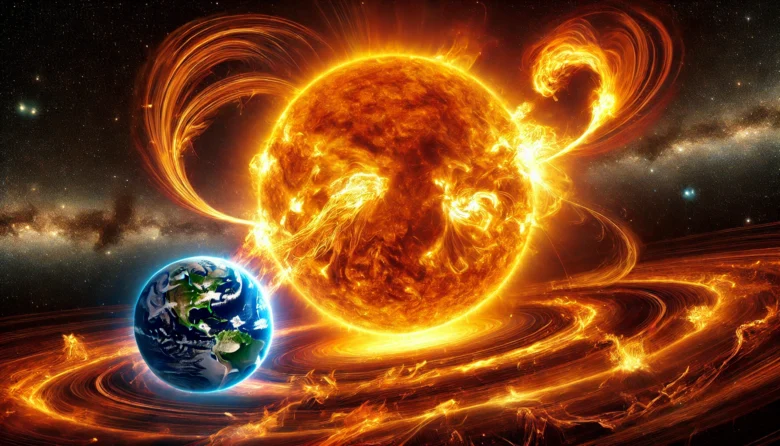Have you ever thought about how vital the sun is in our everyday lives, providing warmth and aiding in plant growth? But did you know that the sun can also affect our planet in ways we can’t see with the naked eye? One of the most intriguing yet less understood phenomena is the impact of solar flares on Earth’s atmosphere. Solar flares might sound like something out of a science fiction movie, but they are very real and can have significant consequences for our planet.
What Are Solar Flares?
To grasp how solar flares affect Earth’s atmosphere, it’s important to first understand what they are. Solar flares are sudden, intense eruptions of radiation from the sun’s surface. These bursts occur when the sun’s magnetic energy is suddenly released, often associated with sunspots—those dark patches on the sun’s surface that you might have seen in pictures.
Solar flares can vary in size, from relatively small ones that cause little disturbance to massive ones that can disrupt satellite communications and power grids and even affect the Earth’s atmosphere.
How Do Solar Flares Affect the Earth?
When a solar flare happens, it releases a stream of charged particles, mostly protons and electrons, directed toward Earth. While our planet’s magnetic field does an excellent job of protecting us from the worst effects, solar flares can still impact our atmosphere in several ways.
Disruption of Communication Systems
One of the most immediate effects of solar flares on Earth’s atmosphere is the disruption of radio communications. The charged particles can interfere with the ionosphere, a layer of Earth’s atmosphere that reflects and modifies radio waves. This can lead to degraded or completely lost signals, particularly for high-frequency (HF) radio communications used by aircraft, ships, and emergency services.

Impact on Satellites
Satellites orbiting Earth are not immune to the effects of solar flares. The influx of charged particles can damage the sensitive electronics on board, degrade solar panels, and even alter the satellite’s orbit. This can lead to interrupted services, such as GPS, weather forecasting, and communication networks that we rely on daily.
Auroras: The Beautiful Side of Solar Flares
While solar flares can cause disruptions, they are also responsible for one of the most beautiful natural phenomena—the auroras, commonly known as the Northern and Southern Lights. When charged particles from a solar flare collide with Earth’s magnetic field, they are drawn toward the poles, where they interact with gases in the atmosphere. This interaction causes the gases to glow, creating mesmerizing light displays in the sky.
Effects on Earth’s Climate
There is ongoing research into how solar flares might influence Earth’s climate. Some studies suggest that large solar flares can temporarily alter the temperature of the Earth’s upper atmosphere. While these changes are generally short-lived, they can contribute to longer-term variations in climate patterns, although the exact mechanisms are still being studied.
Case Study: The Carrington Event
The most famous example of a solar flare’s impact on Earth is the Carrington Event of 1859. This was the most intense solar flare ever documented, and it led to widespread disturbances. Telegraph systems, the primary means of communication at the time, were knocked out across Europe and North America. Some telegraph operators even reported receiving electric shocks, and sparks flew from their equipment.
If an event of this magnitude were to happen today, the impact could be far more severe, given our reliance on electronic systems for everything from communications to banking.
https://www.youtube.com/watch?v=wwRunxYe704&pp=ygUuIEltcGFjdCBvZiBTb2xhciBGbGFyZXMgb24gRWFydGgncyBBdG1vc3BoZXJlIA%3D%3D
The Future: Preparing for Solar Flares
Given the potential impact of solar flares, it’s essential to prepare for them. Governments and organizations worldwide are working on ways to predict solar flares and mitigate their effects. For example, NASA’s Solar Dynamics Observatory (SDO) constantly monitors the sun, providing data that can help predict solar flare activity.
In addition, scientists are developing more resilient technologies that can withstand the effects of solar flares. These include hardening satellites against radiation and creating more robust power grid systems that can resist the surge of energy from a solar flare.
However, there is still much to learn about solar flares and their full impact on Earth’s atmosphere. Continued research is crucial to understanding how we can better protect our planet and our way of life from these powerful solar events.
Conclusion
Solar flares are a captivating and powerful natural event that can greatly influence Earth’s atmosphere. From disrupting communication systems to creating stunning auroras, the effects of solar flares are far-reaching and complex. As our reliance on technology grows, understanding and preparing for solar flares becomes increasingly important. By staying informed and backing scientific research, we can reduce the risks and continue to benefit from our interconnected world.
Author’s Note
The sun is more than just a source of light and warmth; it’s a dynamic and sometimes unpredictable force that can impact our lives in unexpected ways. Solar flares are a reminder of the power and complexity of our nearest star. I hope this blog has shed some light on how solar flares affect our atmosphere and what we can do to prepare for them.
G.C., Ecosociosphere contributor.




